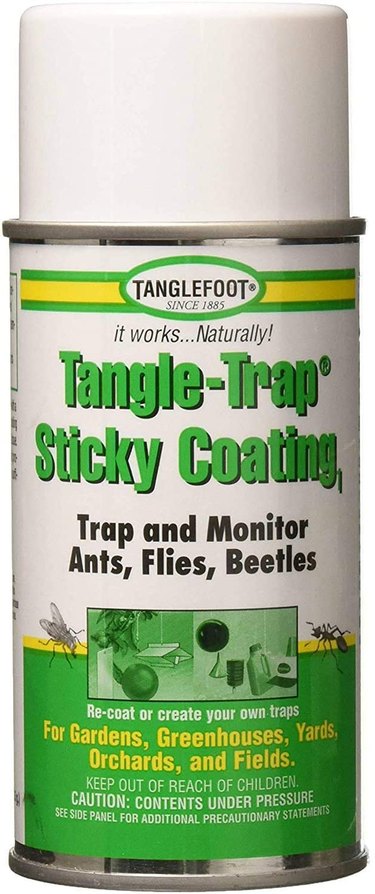Even though science and history have proven otherwise, there's still a lingering myth about earwigs, hinted at in its common name and supported by its somewhat ominous appearance. Once thought to burrow into someone's ear, where it would tunnel to the brain and lay its eggs, the earwig's reputation confers only a bad rap to this scavenging insect. If the sight of an earwig triggers this anecdotal horror story for you, take heart – your ear is safe. However, some of the plants in your garden may not be safe from earwig damage, including roses, daylilies and even corn.
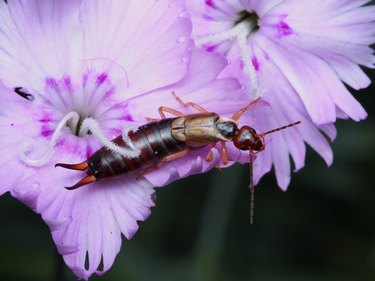
Video of the Day
Before you reach for an insecticide at first notice of an earwig or two on your plants, you may want to weigh their good vs. bad qualities on a mental scale. Sure, they can be a pest in the garden, but they can also be a beneficial insect. This dichotomous quality may tip the scale in favor of "good" instead of "bad" as you decide to give the earwigs in your garden a free pass, but if populations of this insect are out of control and large numbers of your plants are suffering damage as a result, earwig control options include some surprisingly easy remedies.
Video of the Day
Earwig Identification and Life Cycle
As a member of the insect order Dermaptera, the earwig's threatening appearance also gives it another of its common names – pincher bug or pincerbug – because of the appendages at its tail end. A pair of pincers, which resemble forceps, appear on the male and female. The male's pincers are rounded, and the female's pincers are straight. You may not want to tempt fate and provoke an earwig using your bare hands, but you'll only experience a weak pinch if its pincers grab your finger.
Although there are different genera and species of earwigs, this insect's appearance is similar regardless of its taxonomic classification. Adults are typically around 3/4 inch long with a brown to reddish-brown or black slender body that may be striped. They rarely fly, but most species do have wings, which are concealed beneath protective coverings.
A female earwig lays her eggs in an underground nest in clusters of 30 or more. The hatchling nymphs look just like the adults except smaller and white in color, and they progress through a series of four molts as instars to shed their skins as they grow. The first instar nymphs remain in the nest, where they're fed and protected by their mother. The second instar nymphs begin to venture out of the nest at night to forage, but they return to the safety of the nest by daybreak. By the third and fourth molt, the nymphs are able to fend for themselves.
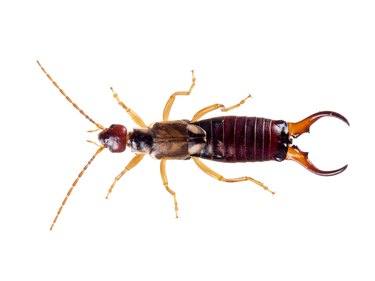
Favorite Earwig Habitats
As nocturnal insects, earwigs feed mostly at night and seek refuge during daylight hours in small, moist, dark spaces. You may see them under rocks, in the mulch around your plants or in woodpiles. As opportunistic creatures, earwigs may retreat inside holes in fruit made by other pests.
Drawn to moisture, earwigs also favor the environment around a dripping outdoor faucet, leaky garden hose or downspout splash block. They may also come into your home through tiny cracks, crevices or larger holes and are attracted to damp, moist places, such as basements or bathrooms.
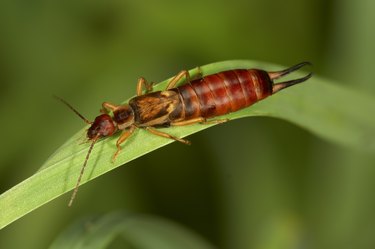
Earwigs as Pests and Beneficials
In your landscape, beneficial insects and other organisms, also simply called "beneficials," prey on pests, such as other insects and bugs, that damage your plants. As beneficials, earwigs eat tons of aphids that literally suck the life out of your plants by feeding on cell sap. Earwigs also prey on other plant pests, such as caterpillars and mites. The flip side of this impressive resume is that earwigs can also be pests themselves.
They burrow into flowers and chew holes in the petals, they can chew tender seedlings to the ground and they eat corn silks, which inhibits pollination and prevents corn kernels from developing. So, are earwigs primarily pests or predominantly beneficials? There's no right answer to this question because it's entirely location-, plant- and garden-specific. In a well-maintained garden with healthy plants, it would take an inordinate number of earwigs to cause a significant amount of damage.
Earwig Control in the Garden
If your plants in general are sustaining significant damage (or if a specific ornamental plant or edible crop is being eaten by earwigs, like your prizewinning roses), it's time to consider them pests instead of beneficials. Without having to use synthetic chemical pesticides, trapping and habitat exclusion are the least toxic ways to control earwigs. Synthetic chemicals will kill earwigs, but they'll also kill the beneficials in your garden. Some types of organic chemicals even pose a life-threatening risk to some pollinators, including bees.
Since earwigs primarily feed at night, you can shine a flashlight on your plants and flowers when it's dark to confirm the problem is earwigs. Even during the daytime, you may be able to differentiate between slug/snail feeding and earwig damage. Slugs and snails also chew holes in leaves and flowers, which looks similar to earwig damage, but earwigs don't leave slime trails like these garden mollusks.
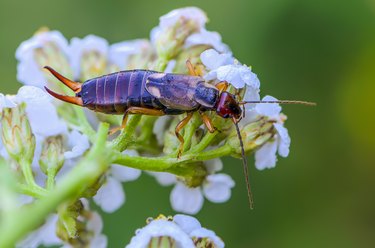
DIY Earwig Traps
You won't have to buy special earwig traps to collect these insects. By using some products that you probably have in your kitchen, you can make a DIY earwig trap. All you need is a plastic container, such as one that holds yogurt or sour cream, or a metal can that holds tuna or cat food and some oil. If you use a plastic container and its lid, your earwig trap will also be lidded to keep out rain and debris while still trapping earwigs.
Poke some holes around the top of your plastic container and add 1 inch of vegetable oil or fish oil from drained tuna. A lidded trap also keeps cats and other nighttime visitors from lapping up the bait inside. Cover the container with its lid and sink the trap into the soil so that the holes are a couple of inches above soil level. At night, earwigs will crawl into the holes and meet their demise in the oil.
Commercial Earwig Traps
Earwigs will even climb trees to reach succulent tree fruit. Use a commercial product that's specifically designed to trap climbing pests with a sticky substance that you brush on, spray on or wrap around your fruit trees. Tree Tanglefoot® is a sticky substance that you apply with a putty knife to the enclosed insect barrier band, which you wrap around tree trunks. You can also use Tanglefoot's Tangle-Trap® product, which is a sticky coating in aerosol form that you apply to cardboard or even duct tape that you wrap around tree trunks.
Product Recap
- Sticky coating in a tub applied with a putty knife to the enclosed insect barrier band
- Ready to use
- Weatherproof
- OMRI rated for organic gardening
- Sticky coating in aerosol form
- Apply to your own DIY insect barrier band
- Reapply as needed

